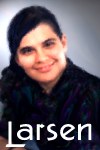making history together
Recently, Eastgate authors Bill Bly and Deena Larsen were talking about open hypertext worlds -- what Michael Joyce calls "constructive hypertexts" -- works that are created as frameworks in which other writers can realize new visions. Role-playing worlds and MUDs can be constructive hypertexts if the participants take them seriously, treating them as performance spaces rather than as juvenile chat lines. But more interesting in the long run are works of art that are crafted as starting points for the imagination.

For example, Deena Larsen's Marble Springs is a hypertextual collection of interlinked poems about the lives of the women who built the 19th century frontier town of Marble Springs, Colorado. Marble Springs invites the reader to fill in missing stories and extend the work. (Deena Larsen is currently collecting contributions from readers to create a Second Edition)
From Bly's conversation with Larsen:
| Bill Bly | What kind of contributors to Marble Springs have you acquired thus far? |
| Deena Larsen | Few of the contributors thus far have been "strangers". Either people wrote to me about Marble Springs, or I've asked acquaintances to write something. I once lived in San Francisco, where I was a part of a great writers' group for a long time. The group is still going strong, and I asked them to write something for Marble Springs. At their next meeting, though, one writer very eloquently explained how it absolutely could not be done, why you could not add to another's vision. Then Robert Smith came up and read his offering: a lovely montage about chokecherrry wine, to tuck inside Doc Nancy's poem. He caught the essence of Zandra and Millie and lots of others. Ray Kerr came up with a great new version of Bridget, which goes further than the original in explaining her loneliness and need to kill her child. The skeptical writer said, yeah, well, with any other work you couldn't do it.
Many of the contributors have explored the work with me. They come over to my house, eat pizza and create stories/poems. (If I were a much better cook, I'd have a lot more contributors.) We read through Marble Springs on my computer and ask things like "Why would Bart Mateson gamble for Ruby, settle for Lizzie, have 13 kids, and then shoot up the town when Ruby came back?"This intense collaboration is what I had in mind when I wrote Marble Springs. I wanted a piece where students who were unsure about writing their own characters or setting could "jump off" and start to research and write. |
| Bill Bly | Does having others put their two cents in make for a better hypertext? A better work of art? |
| Deena Larsen | Marble Springs is meant to be an open work. For some personal, psychological reasons, I really didn't want to write it that way, and if I could have seen any way NOT to do it as a collaborative work, I would have. But the whole POINT of Marble Springs (and I can't stress this enough) is that the work is open. Connections beget connections, which beget still further connections. There is no end to the number of people in the chain. And each character can be seen in an infinite number of ways. I wanted to open a small door into the vast possibilities, and show that by writing a version you don't ever nail it down as fact, but instead increase the infinite number of possibilities. |
| Bill Bly | What plans do you have for the "alternate versions" of characters and/or the writings that pertain to them? |
| Deena Larsen | I am going to include alternate versions for both mentioned characters (where the poem space is blank) and original characters like (where there is a first edition poem). You will see a button on the right hand upper corner of the screen that says "Chris' version" or "Adolph's version." Click on that button and you will get a card field which shows that version in the poem space. |
| Bill Bly | If no one version is nailed down as fact, how do you keep the world intact? Don't different versions of the story, different variations on each character, reduce the story to a muddle of variants? |
| Deen Larsen | Marble Springs will always be inconsistent. I tried for the longest time to have internal consistency--making sure that characters met each other when they were actually alive and in town. In fact, I have an extremely elaborate time schedule. But eventually I saw a choice between slavishly reflecting an imagined reality and embracing a multitude of mutually incompatible possibilities. Writing "historical" fiction compounds inconsistencies as you have many different worlds to reflect: the "historical" world and its many variants along with the writer's world. I grew up using Marble Springs as a way to mirror whatever happened in "real life" with a story. For example, "Confinement" stems from a thirteen-year-old pregnant girl I knew in a shelter. In an open hypertext, the collaborator's versions of characters and their own worlds come into play. So you can see where it gets complicated and intertwingled. To capitalize further on this confusion, the author page poses the mystery of which character in the story wrote Marble Springs. It is not only unclear how accurate these missives are, but where they came from and who wrote them. I am perfectly comfortable with a wide variety of internal suspects, ranging from Zandra Miller to Susannah Smith to Edna Harris or even Sophie Smith Weaver, the 1990's "great granddaughter." |
Creating shared worlds of the imagination -- what Michael Joyce in Of Two Minds calls "a structure for what does not yet exist" -- is among the most exciting challenges for today's hypertext writer.
